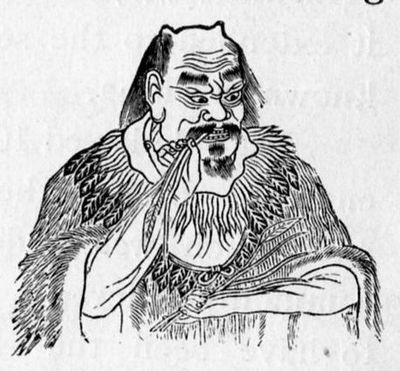
Search
Yan Emperor

The Yan Emperor (Chinese: 炎帝; pinyin: Yán Dì) or the Flame Emperor was a legendary ancient Chinese ruler in pre-dynastic times. Modern scholarship has identified the Sheep's Head Mountains (Yángtóu Shān) just north of Baoji in Shaanxi Province as his homeland and territory.
A long debate has existed over whether or not the Yan Emperor was the same person as the legendary Shennong. An academic conference held in China in 2004 achieved general consensus that the Yan Emperor and Shennong were the same person. Another possibility is that the term "Yan Emperor" or "Flame Emperor" was a title, held by dynastic succession of tribal lords, with Shennong being known as Yandi perhaps posthumously. Accordingly, the term "Yan Emperors" or "Flame Emperors" would be generally more correct. The succession of these Yan or Flame emperors, from Shennong, the first Yan Emperor, until the time of the last Yan Emperor's defeat by the Yellow Emperor, may have been some 500 years.
Historical records
No written records are known to exist from the era of Yan Emperor's reign. However, he and Shennong are mentioned in many of the classic works of ancient China. Yan literally means "flame", implying that Yan Emperor's people possibly uphold a symbol of fire as their tribal totems. K. C. Wu speculates that this appellation may be connected with the use of fire to clear the fields in slash and burn agriculture. In any case, it appears that agricultural innovations by Shennong and his descendants contributed to some sort of socioeconomic success that led them to style themselves as di (帝; 'emperors'), rather than hou (侯; 'lord'), as in the case of lesser tribal leaders. At this time it appears that there were only the bare beginnings of written language, and that for record keeping a system of knotting strings (perhaps similar to quipu) was in use. The Zuo Zhuan states that in 525 BC, the descendants of Yan were recognized as long having been masters of fire and having used fire in their names. Yan Emperor was known as "Emperor of the South"
Downfall
The last Yan Emperor, Yuwang, met the end of his reign in the third of a series of three battles, known as the Battle of Banquan. The exact location of this battle is disputed among modern historians, due to multiple locations adopting the same name at various points through history. Possible candidates include Zhuolu County and Huailai County in Zhangjiakou, Hebei, Yanqing District in Beijing, Fugou County in Zhoukou, Henan, and Yanhu District in Yuncheng, Shanxi.
The Yan Emperor, retreating from a recent invasion from the forces of Chiyou, came into territorial conflict with its neighbouring Youxiong tribes, led by the Yellow Emperor. The Yan Emperor was defeated after three successive battles and surrendered to the Yellow Emperor, who assumed the title of overlord (共主) and agreed to merge the two tribes into a new confederation — the Yanhuang tribe. Under the Yellow Emperor's leadership, the newly combined tribes then went to war and defeated Chiyou in the Battle of Zhuolu, and established their cultural and political dominance in China proper.
Historicity
Since the Battle of Banquan is treated as a historical fact by Sima Qian in his Records of the Grand Historian, it would appear that this is a pivotal transition point between mythology and history. Ironically, Yan Emperor enters history only with his submission to the will of the Yellow Emperor. In any case, the title of flame emperor apparently lapsed after this time, while his tribe's descendants were said to be perpetuated through intermarriage with that of the Yellow Emperor, and Han Chinese throughout history have referred themselves as the "Descendants of Yan and Huang".
In traditional culture
Both Huangdi and Yandi are considered in some sense ancestral to Chinese culture and people. Also, the tradition of associating a certain color with a particular dynasty may have begun with the Flame Emperors. According to the Five Elements, or Wu Xing model, red, fire, should be succeeded by yellow, earth—or Yandi by Huangdi.
According to the records of ancient history books such as The "Đại Việt sử ký toàn thư", the earliest monarch of Vietnam, Hồng Bàng, was a descendant of Emperor Yan. Because of it, all the ancient Vietnamese dynasties regarded Emperor Yan as their common ancestor.
List of Flame Emperors
This is the most common list given by Huangfu Mi, Xu Zheng, and Sima Zhen:
List provided at the end of the Shan Hai Jing:
See also
- Descendants of Yan and Yellow Emperors
- Emperors Yan and Huang (monument)
- Huaxia
- Shennong
- Three Sovereigns and Five Emperors
- Yao Grass
- Yellow Emperor
- Zhonghua Minzu
References
Citations
Sources
Text submitted to CC-BY-SA license. Source: Yan Emperor by Wikipedia (Historical)
Articles connexes
- Emperor Wu of Jin
- Yan (An–Shi)
- Yan Huang Zisun
- Yellow Emperor
- Emperors Yan and Huang
- Jiajing Emperor
- Liu Yan (emperor)
- Shennong
- Yanhuang
- Three Sovereigns and Five Emperors
- Emperor Daizong of Tang
- Emperor Daowu of Northern Wei
- Yan Liben
- Shaodian
- Later Yan
- Chinese mythology
- Emperor Guangwu of Han
- Yuwang
- Yaoji
- Fights Break Spheres
Owlapps.net - since 2012 - Les chouettes applications du hibou


